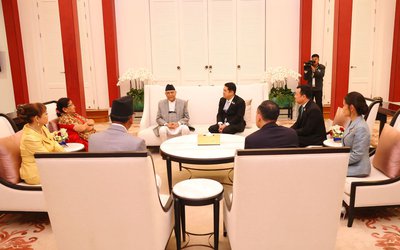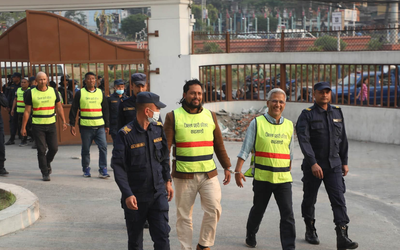More on News




“You play the guitar on the M.T.V.
That ain’t working, that’s the way you do it
Money for Nothing and your chicks for free”:
Dire Straits, 1984: “Money for Nothing”
Dire Straits, a British rock group of the 1980’s, captured the envy of the working men, who “have to move these refrigerators, these color T.V.s. and install microwave ovens” against “them faggots on the M.T.V. who ain’t dumb, own their jets and have chicks for free, playing on the M.T.V. but that ain’t working!”
This envy captures the resentment and grudging respect of the rest of the world at China’s unstoppable economic machine rushing past Japan, morphing into the second largest economy in the world, and shoring up the biggest economy, the US till date, with trillion dollar bank guarantees to cover its crippling debt. According to World Bank, China accounts for 60% of all people of the world lifted out of poverty, about a half a billion, while its rival, India, is still saddled with the largest number of poor people of the world.
While the West has burdened the Earth with global warming from their 300 years of industrial revolution atmospheric pollution, China is the world leader in the scale of its advances in Green economy. According to a commentary on Global Vision for Rio 20 and Beyond, published in the Economic and Political Weekly in October 2011, Mukul Sanwal, a former Special Advisor to the United Nations Framework Convention for Climate Change, UNFCCC, secretariat: “a recent comparison of Copenhagen emission pledges concludes that China would contribute over 40% of total abatement by all countries, more than the total abatement by all developed countries combined, and more than 2.5 times the amount of abatement undertaken by the United States and over five times the European Union’s Kyoto commitment.” China is proving that it is possible to decouple booming economic growth from devastating environmental degradation by investing $468 billion in key green sectors of the economy by 2015, double the past five years, according to the United Nations Environmental Program, 2011.
Environmental degradation was a necessary price for economic growth in the Western developmental model just like the necessary accessories of Western style multiparty democracy and the hegemony of unelected private sector corporations and non-governmental organizations. But China has already produced three decades of robust State-led growth without the aforementioned, ‘necessary’ accessories. And China’s development has been more successful at poverty reduction of society’s bottom than the models offered by USA and India. In USA, the Occupy Wall Street movement is now sweeping cities to protest the top 1% capturing more wealth than the bottom 99%. Closer home, the India Shining electoral boosterism of business-backed, rightist Bharatiya Janata Party of India lost to the centrist-leftist coalition that made it plain, NOT TO FORGET the teeming millions still suffering, in poverty.
Are all of these gains only due to the Deng Xiaoping introduced liberalization of the1978s, as the popular think tanks of the West, such as the World Bank, would have us believe? These scholars point to the nearly double digit economic growth since Deng’s correction to Mao’s follies. Mao’s Great Leap Forward and the Cultural Revolution cost 30-70 million ‘indirect’ deaths due to famine, starvation and lost growth and nearly 1 million ‘direct’ deaths due to torture and persecution while the economic growth hovered below 5% a year, much like in Nepal over the last decade of conflict.
However, as Nietzsche declared, ‘all present is the summation of all past’. So Mao’s social engineering is credited with preparing the ideological, economical and physical foundations for Deng’s policies to takeoff. These include mass social learning: a) that the landed class may no longer rule with their inequitable land holdings, by having their land holdings seized and delivered to the poor masses; b) that the Communist Party of China really does deliver the goods, the land, to the maximum population base, earning their unwavering loyalty even through the trying social experiments such as the draconian restrictions on rural to urban migration; c) that the so-called intellectual flotsam, the bespectacled urban upper class, needed to go ‘Back to Village’, to learn that they were not more equal than the rural, toiling masses with hands dirty; d) that every rural household could be transformed to mass, individual, industrial manufacturing units capable of faster relief from poverty than the slow-paced agriculture ; to produce, presto, e) the fundamental building block for transformation into the world’s manufacturing power house.
In a country with the largest population of the world at 1.4 billion now, and even among the four river basins of the world since the dawn of human civilization in: the Yellow River Basin of China, the Mohenjo-Daro Harappa of the Indus, the Mesopotamian, Euphrates and Tigris of modern day Iraq, and the Nile River Valley of Egypt, around 3000-1500 B.C., mass learning to facilitate extremely large scale social undertakings, unfractured by cultural, geographical, political or other divisiveness, seems to be a unique cultural legacy of China. As early as the 5th century or even earlier, the great human feat of the Great Wall of China, nearly 9000 km long, or ten times the length of Nepal, and supposedly visible from space, was taken on as a gigantic social enterprise spanning centuries and completed around the 16th century Ming dynasty, to protect the prosperous agricultural population from the marauding cavalry of the Mongols and the barbarians from the northwest.
The other important, latter day, mass social learning and undertakings include: a) pauperization inflicted through the millennia by imperial dynasties (the Hsia, Shang, Han, Ming, Qing,to name just a few); b) the humiliating unequal treaties and opium forced onto the Chinese by the cannonading British, in late nineteenth century; c) leading to a mass yearning to throw off the yokes of imperial overlords of the country and beyond; d) that built the ground work for so-called great leaders of the twentieth century, Sun Yat-sen, Chiang Kai Shek, Mao Zedong, and Deng Xiaoping to emerge; and more recently, e) to push down the country’s population growth rate to 0.57% per year now, less than half of Nepal’s 1.4%, with its 1-child policy.
to be continued...
Amulya is at Kathmandu University



